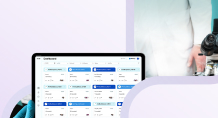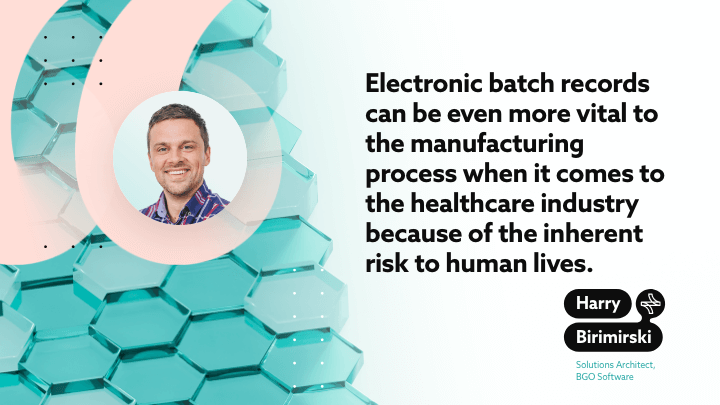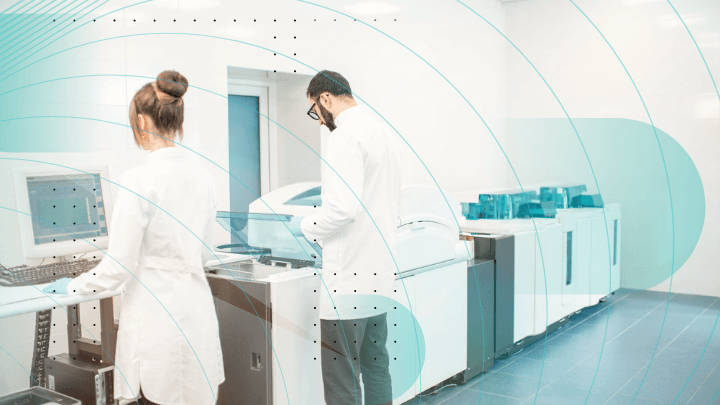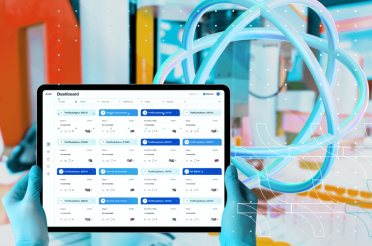There isn’t a company in any kind of industry that deals with manufacturing and doesn’t know about Good Manufacturing Practices (GMP). These practices are a fundamental part of creating any sort of product, be it a healthcare product or not.
In the healthcare industry, GMP is an even bigger necessity. The reason is because they are made to directly influence people’s health. An inextricable part of good manufacturing practices is Electronic Batch Records (EBR). EBR is the digital backbone of GMP compliance and is vital for its efficient and continued use in the future.
To better understand the importance of EBR software in the sphere of good manufacturing practice, we have interviewed one of our BGO experts – Lead Software Engineer Harry Birimirski.
What is the application of EBR software in GMP?
EBR software transforms batch records into digital formats, storing all relevant data electronically. It guides operators through each step of the manufacturing process, ensuring adherence to standardized procedures and regulatory requirements.
The software takes the information that is digitally stored in a batch production record and analyzes it to provide thorough data on the manufacturing process.
Batch records, on the other hand, are traditionally used in manufacturing processes, especially in the pharmaceutical industry and biotechnology. Such records document the entire manufacturing process of a batch of a product. This documentation helps us get a comprehensive and traceable record of all activities related to the production process.
Electronic batch record software facilitates the conversion of paper-based batch records into digital formats, automates data collection from machinery, and enables us to create customized workflows with tailored forms for each product.
EBR systems are widely employed in various industries for tracking and tracing the manufacturing of goods.
The benefits of EBR software in healthcare
Healthcare products have to deal directly with human lives. It is an absolute necessity that the products that are created are completely compliant with the guidelines and regulations in place to protect the consumers, in this case, patients.
According to Harry, using EBR software has a lot of benefits that provide the needed security in the development of the products, especially when they are intended for the healthcare industry.
To better understand the simple way batch records give information in order to follow GMP principles, our expert gives examples with a couple of these principles. Good manufacturing practices are intended to optimize and secure the production workflow. We have to have prior information and data to analyze the mistakes and inefficiencies according to GMP to bring forth fixes and changes.
There are a couple of guidelines that GMP considers the most:
- Personnel training and hygiene: Ensuring staff are trained and maintain proper hygiene to prevent contamination.
- Premises and equipment: Maintaining facilities and equipment in a clean and orderly manner to prevent contamination and ensure product quality.
- Material control and supplier management: Establishing standard operating procedures for the receipt, storage, and use of materials to prevent contamination and ensure quality.
- Quality control and testing: Conducting testing and analysis to verify product quality and compliance with specifications.
- Complaint handling and product recall: Establishing procedures for handling customer complaints and recalling products if necessary.
Just like there are a couple of principles and aspects of development GMP looks out for, EBR actually manages to obtain information and provide efficient records for analysis.
These include:
- Formulation details: Specifies ingredients and quantities for product consistency.
- Critical process parameters: Monitors factors like temperature and pressure for manufacturing consistency.
- Equipment and materials usage: Tracks complete data of machinery, materials, and their calibration status for reliability.
- Procedural steps: Outlines sequential procedures to ensure standardized processes, help process optimization, and improve operational efficiency.
- Testing and quality control results: Validates product quality and compliance with specifications.
- Deviations/non-conformances: Records and addresses any deviations from standard procedures.
“You cannot make a prediction without any data history.”
We need to use electronic batch record systems to fully utilize the power that is GMP compliance. There is so much information that EBR provides us with. When we use this raw data, that is made easy to analyze using the software for organizing it, we can make predictions that make the whole manufacturing process much more efficient.
How can EBR software work for your manufacturing?
The EBR system offers several advantages for your plant’s operations.
Firstly, it provides a workflow planning tool that allows you to model the documentation flow of Master Batch Records (MBRs). With this feature, You can build dedicated workflows tailored to specific products or product groups, assigning a list of tasks to be performed at various stages of the process.
Additionally, you can display all processes and templates and customize projects by adding sections and fields through drag-and-drop functionality. This feature is achieved through a system Builder tool for creating MBR templates. Moreover, the production execution module facilitates efficient production management.
This functionality is based on four aspects:
- Handling the start-up of production orders;
- Validating processes before production begins;
- Guiding operators through production stages with the display of data analytics;
- Automatically registering order fulfillment and capturing data.
There is a certain ideal version of the modern manufacturing process that is created with the help of all the information EBR software gathers. And that ideal version is what helps make the manufacturing system even more efficient by trying to get the perfect scenario with each product.
“On the basis of the gathered data from the system we create an ideal model of the entire process – a golden batch.”
Lastly, the system allows for easy generation of PDF reports and automatically generates reports that summarize batch releases and stores them within the system for convenient access and reference.
Having detailed digital records on the entire process is what drives the entire concept of analysis that creating such golden batch models is based on.
EBR software features
When we talk about EBR software and how it can help an entire manufacturing process reach even greater heights, we need to talk about some of the features that such software offers.
For example, digital documentation enables users to access documentation online via the operator panel. It categorizes PDFs, images, and videos for real-time display during production processes.
Another prime feature is traceability, which allows for tracking and tracing of finished goods, semi-finished goods, and raw materials throughout production. It matches ongoing production with serial numbers, batches, and containers, validating processes and confirming scanned resources. Labeling is automated at each production step, which allows easy retrieval of raw materials based on scanned finished goods and vice versa.
One of the most important and irreplaceable features of EBR software is a Master Batch Record (MBR), which involves setting up templates in the system with activities sequenced appropriately. Each activity can be configured with reporting data types such as numbers, text, or data from automation, validated against quality limits.
The paperless operations approach guides operators through production activities, providing dedicated and detailed documentation (images, documents, movies) for each step. Factory forms allow for the transfer of any paper-based forms into the system.
Furthermore, quality inspections automate periodic quality tests, instantly confirming measurements against quality limits. Measurements are sourced from automation or provided manually by operators.
The challenges of creating an EBR system in healthcare
Using any type of software in the healthcare industry is usually a big step in any one direction.
Given the nature of this industry and how much it involves people’s lives, it is very important to have everything straightened out to the last detail. The last detail sometimes involves even the system that just manages the manufacturing process of a healthcare product.
It can be challenging to select the right software for your manufacturing needs but it can also be very difficult to create it. Usually there is always the option to buy ready-made software, but most companies nowadays choose custom-made healthcare solutions because of their more versatile nature. It is very difficult to make such software and takes a lot of time and expertise.
“The most difficult part of making healthcare software is making sure it’s CSV compliant.”
According to our expert, having healthcare software, even one such as an EBR system, Computer System Validation (CSV) compliant is the most difficult part of the development process. There are usually many different guidelines that need to be followed in order for a software solution to show it is compliant with CSV principles.
To ensure compliance with regulatory requirements and industry standards there must be careful consideration in implementing EBR software. One crucial aspect of this process is validation documentation, which involves creating comprehensive documentation of the validation process.
What this step includes is the following:
- Validation plans;
- Protocols;
- Test scripts;
- Validation reports.
All of these record keeping essentials are aimed at demonstrating that the software functions as intended and meets regulatory requirements.
Additionally, conducting a thorough risk assessment is necessary to identify and mitigate potential risks to data integrity, patient safety, and regulatory compliance. Implementing audit trails and electronic signatures is vital to prevent unauthorized access of electronic records.
Moreover, system security is a top priority in safeguarding the integrity of data stored and processed by the EBR software. There are a couple of ways this safety is usually achieved. That is by including encryption, authentication, and authorization mechanisms to protect sensitive information.
“You can create software that is not GMP compliant, but it won’t do you much good.”
Our expert also discusses the option of creating such software that doesn’t hold GMP principles as any sort of principle. He mentions that the process of developing such software can be a lot easier, but that is only because the final product is nothing more than a simple information system.
GMP-compliant EBR software actually manages to create a system that will make automatic decisions based on certain parameters whereas one that isn’t compliant would just inform you of specific inconsistencies and alerts.
Another challenge Harry talks about is the gap that is created between the software developer and the business owner. Usually in such situations the business owner has a specific idea in mind for the software. In that idea, the software is used to satisfy the business’ requirements while specific technical requirements are not taken into account. The side that has to account for the technical specifications of the product is usually the developer’s.
Bridging the gap between the business and the developers can oftentimes be a difficult phase to overcome. Our expert even gives an example with a project he’s worked on where the aspect that made the gap even more difficult was actually a third requirement that was by the regulating bodies.
In that specific case, the aspects were nonfunctional requirements, which have to do with record keeping and documentation. In such a case, all sides need to be consulted and considered. The communication has to flow as best as possible because such gaps can lead to having to start development all over again.
Integration of Electronic Batch Records with other systems
An extremely challenging aspect of creating any kind of software, especially when the software has to deal with recording data, is its integration with other systems. Oftentimes a business that needs such a system like electronic batch records already has a business that functions.
For a business that deals with manufacturing to function, there are already systems in place, including systems from other businesses that our software has to interact with.
“Imagine making a system that has to be GMP compliant and keep track of raw materials used in the manufacturing process, but in order to do that, you have to integrate it with a third party system that provides those raw materials.”
Our expert delves deep into this challenge of creating EBR software. Integration with other systems that are already existing and functioning can be extremely difficult. There needs to be a lot of communication between all the different parties involved. Even then, it can verge on the impossible if the different software is too incompatible.
Some advice, Harry Birimirski provides is that in order to limit such challenges to a minimum, there need to be clear requirements for what the software has to accomplish. As long as the developed systems achieves those goals and is compliant with regulations, even integration with a completely different software product can be possible.
The future of EBR software in healthcare
Regulations are a big part of creating healthcare software and an EBR system is no exception. There are many different aspects of compliance that need to be considered by developers.
In most cases, the system being developed has to do with a very specific functionality or field, like EBR software, and no matter the experience of a developer, the requirements pose a challenge. The biggest advice our expert gives on the topic, is that the best way to ensure system compliance is to find consultants that deal with regulatory bodies.
“There are just too many different avenues to consider when chasing compliancy. Sometimes consulting experts in regulations is the smartest move.”
The sheer quantity of different rules and guidelines can be overwhelming, especially when developing an already complex product. Consulting people that have specific expertise in the field is the right move to ensure complete compliance.
Regulations, in general, constantly change in different industries. The healthcare industry is one where rules and standards are updated all the time. When developing healthcare software, however, that is not an excuse to disregard such regulations.
According to Harry, however, there are certain trends that are apparent in the regulations from the past couple of years.
Having an expert like Harry who has worked on healthcare software products before and after COVID gives us a clear view of how things were back then and how they are changing right now. There has been a pattern where regulations are becoming more innovation-focused and versatile and not keeping the same standard of being extremely strict like they were before the pandemic.
This can prove to be a step that drives the evolution of new systems and software that may actually change the status quo. No matter how regulations have changed, however, they are still intended to ensure safety and security.
The manufacturing process will always be a fundamental part of the healthcare industry. Utilizing a system that can bring that manufacturing process to its full potential is a vital element of a successful workflow.
You need a developer with extensive expertise in the industry in order to get a software product that not only meets the requirements of your business but also fulfills the regulations safeguarding the people.
BGO Software is definitely a developer that can offer just that.
















